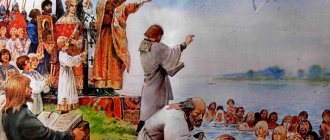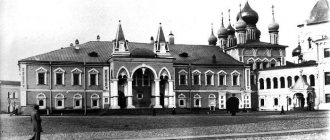When do you think the first centuries of Christianity were? Most likely, the answer will be: “1st–2nd centuries,” but a number of religious experts will argue with this.
The first Christians did not immediately become such, but for many years they were simply a sect within Judaism, so they were not considered as a separate religious tradition.
And yet we all understand that right now we were brought into this article not by interest in the religion that officially replaced paganism in the Roman Empire, but by the desire to learn something new about the first Christian communities organized in the 1st century.
The essence of Christianity in early times is the message of the fulfillment of Jewish prophecy
The history of the Christian church is closely connected with Judaism. Judge for yourself: the birthplace of Christianity is Palestine, its ancient texts are the Old Testament.
Since the time of Moses, prophets have looked into the future and reported that a Redeemer, a Messiah, a certain King of humanity was coming, who would save everyone.
Jesus Christ was not the founder of Christianity, he led the life of a pious Jew
That’s why the Jews were waiting for a king—an ordinary, earthly one. In that era, many impostors appeared trying to attract attention to themselves. But their views and sermons touched the hearts of few. The main teachings, or rather different views on the single core of the Jewish tradition, still prevailed:
- Pharisees are traditionalists, the elite of society;
- Sadducees - reformers, representatives of the lower strata;
- The Essenes are monks who have distanced themselves from the worldly.
Among the influential prophets of the first years of our era can be called John the Baptist. Most likely, based on his views and biography, this man came from the Essenes. This is not yet the founder of Christianity, but the one who will introduce the communal way of life and provide the first audience for Jesus Christ.
the closest predecessor of Jesus Christ, who predicted the coming of the Messiah
Moreover, from the episode of the expulsion of merchants from the temple, we see that Jesus Christ defends the Jewish tradition and clearly values it. So by religion, both Jesus Christ and John the Baptist were Jews, not Christians.
What kind of scrolls?
These are the oldest fragments of the Bible that have survived to this day - or rather, those books that were later combined into the body of Holy Scripture of the Old Testament.
Fragments of manuscripts were first discovered in 1947 in Qumran, a desert site on the northwest coast of the Dead Sea in Israel. To date, about 900 such scrolls have been found, the oldest date back to the mid-3rd century BC, and the most “recent” to the mid-1st century AD. About a third of the manuscripts contain texts from the books of the Old Testament.
Dead Sea Scrolls found in 1947
The basic teachings and ideas of the first Christians have almost never reached us
We know little about the basic teachings of the early Christians due to a lack of sources. They were probably very close to the Judaism of that time, especially to the views of the Essenes.
In slightly later centuries, two main directions emerged:
- Christianity familiar to us . With some amendments, it was this teaching that ultimately provided the basis for the main currents of today's Christianity. It cannot be said that it was a single religion. On the contrary, there were many schools (Antiochene, Roman, etc.).
- Gnostic Christianity . This is a mystical view of Christianity. It focuses on esotericism, which makes these movements similar to Kabbalah. The dawn of this tradition occurred in the 2nd–4th centuries, but even today there are groups of believers who, to one degree or another, inherit these views.
And yet we can say that the main ideas in the traditions overlapped:
- The main Scripture remained the Old Testament (not always) and New Testament texts, but the composition of these canons differed in traditions. There were many apocrypha;
- Christ has always been considered the central figure of religion, although His role has been assessed in different ways.
It is impossible to identify other common features. Some recognized the Old Testament God, others rejected. For some, Jesus is the Messiah, for others he is just a man, etc. The ritual part not only varied, but was also rejected by some traditions.
In general, Christianity quickly became a diverse tradition, which has echoes to this day.
The Christian Church arose after the execution of Jesus Christ, on the day of the Descent of the Holy Spirit
After the death and resurrection of Christ, the first Christian communities arose. Of course, the Savior’s disciples could have gathered earlier, during His lifetime, but, let us repeat, these were not gatherings of people whose religion was Christianity.
Christianity took shape gradually.
30s
1st century - the time of the emergence of Christianity
The 30s can be called the date of the formation of the Christian Church. Usually an event such as the descent of the Holy Spirit on the apostles is associated with it. This was a miraculous phenomenon, after which the disciples of Jesus Christ acquired amazing powers:
- Healed the sick;
- They spoke different languages;
- Showed eloquence;
- They cast out demons.
Sermons began that would become increasingly widespread in the first centuries of Christianity. And gradually, not only the Jewish, but also the Roman authorities realized that they were faced with enormous force.
The cross becomes a Christian symbol (before that there was a fish), the doctrine of the Savior’s sacrifice is formed, the first Gospels are written (possibly based on notes from listeners of Christ’s sermons).
So what's the bottom line?
There are absolutely no serious reasons to talk about the dependence of Christian ideas, and especially the image of Christ the Savior Himself, on the Essene tradition. The content of the Christian gospel is incomparably broader and deeper than those ascetic exercises and moralizing that were characteristic of this Jewish sect.
Well, and most importantly, Christianity could not have survived (not to mention radically expanded and spread throughout the world in a matter of centuries!) if it had simply “followed the footsteps” of the beliefs of the Essene communities - by the way, irretrievably disappeared under the boots of the Romans in 70.
The editors of “Foma” would like to thank Archpriest Dimitry Yurevich, head, for his help in preparing the material. Department of Biblical Studies of the St. Petersburg Orthodox Theological Academy
The first Christian temple was an ordinary building, and churches began to be built in the 4th century
We are unlikely to know when and where the first Christian temple in the world appeared. The fact is that the sermons took place underground. Of course, no one erected buildings with Orthodox domes.
The Basilica of St. Lawrence is similar from the inside to what the first Christian churches looked like in the 4th century
The first Christians were ordinary people, they had some housing. This is how people gathered for “apartments” - secretly, so that representatives of the Roman or Jewish authorities would not find out.
But it was construction that began under Emperor Constantine. This is already quite a late time - the 4th century.
Constantine understood that the Roman people would not happily accept the changes imposed on them, so he tried to build the first Christian buildings away from city centers. But this still did not save them from arson.
Constantine did not want his buildings to be somehow associated with pagan temples, and therefore chose the architectural form of the basilica, “untainted” by foreign beliefs. The word “basilica” is consonant with the name of “Bezaleel” - the one who built the Tabernacle of the Meeting, the prototype of the Jewish and Christian temple.
Doctor of Historical Sciences Oleg Sergeevich Voskoboynikov writes about these buildings:
Oleg Voskoboynikov
Doctor of Historical Sciences
“If we enter the Lateran Basilica, the very space that opens up before us is close to what Christians who emerged from underground must have seen in the 4th century. And if we enter the basilicas of St. Paul and St. Lawrence, then there will be approximately the same situation. This is a long nave, that is, a ship (or an ark in the language of that time), covered with a wooden ceiling (I emphasize - a ceiling, not a vault), and a row of columns, beautiful antique columns. They burned a lot, many of them were restored, new columns were installed. But, one way or another, these are three or five naves, which from the west lead us to the east to the round apse. The apse is a semicircular altar space ending at the top with a concha (shell), which usually housed a mosaic image of the heavenly Sovereign.
What the Roman basilica of the time of Constantine was like, we can learn partly from these temples standing on the ground, partly from old images. The Vatican Basilica was completely rebuilt on the site of the old one. But the Lateran Basilica, the Basilica of the Martyr Lawrence and St. Paul, is approximately the same size as it was then. The outside of the temple was not actually decorated. In any case, there were no images, except that a small semicircular image could be placed above the entrance to the temple or some kind of inscription or the doors could be decorated with wooden carvings.”
Of course, the paucity of external design is not accidental. They tried to design the inside of the temples in the most expressive way to show that it was here, in the temple, that there was a place where God descended.
The first Christians had a priestly hierarchy, and we know approximately how these people prayed
In the early years of Christianity, there was no uniform pattern of worship. Each community had its own principles. There are only isolated reports about how everything was arranged in some of them.
But we must take into account that the first Christian historians are several centuries distant from the first Christians. So the way the first Christians prayed and performed divine services may be very different from the picture that has come down to us.
Therefore, further information should be taken with some skepticism.
It is impossible to say for sure about the prayers of early Christians; there is only later information.
N. I. Feshin “Exit from the catacombs after prayer” (1903). The first difficulty, which arose before Christians almost at the very beginning and then was constantly present in their lives until the 4th century, came from outside - from persecutors and enemies of the Church
After baptism, people joined the Christian church. We know little about its structure in the first centuries. But already from the book of the Acts of the Holy Apostles it is clear that these people called themselves Christians and had a priestly hierarchy.
Today all we have left of it are its names. All the functions of various dignitaries and positions have been significantly mixed up in the course of history.
We know that the first Christians practiced evening and morning prayer. They, of course, took a model of this from the Jewish tradition. There were also prayers tied to the clock.
The pagan influences that have passed since the times of ancient people through all religions have not gone away either:
- prayed to the East;
- They gathered for services on the day of the sun - on Sundays.
Although, of course, Christians had their own motives for precisely this order of ritual life.
Early Christian authors report on the Sacraments. Baptism and the Eucharist began to accompany Christianity quite early.
And what does the mentioned Essenes have to do with it?
Also preserved are scrolls containing fragments of treatises and commentaries on biblical books authored by the Essenes, a Jewish religious movement, one of whose communities lived precisely on the northwestern coast of the Dead Sea. For a long time it was believed that Qumran was the place of settlement of the Essenes. Only in the early 2000s, thanks to excavations carried out by Israeli archaeologists Yitzhak Magen and Yuval Peleg, it became clear that there was no religious settlement in Qumran: at the turn of two eras - pre-Christian and Christian - there was a ceramics factory there. And the Essene community, obviously, was located in a slightly different place - in the Ein Gedi area.
The first written sources of Christianity have not reached us
The Christian faith acquired its dogmas and scriptures quite late. The first collections of the New Testament date back to the 4th century. The canon was established even later.
The first written sources of Christianity probably only briefly described the life of Jesus Christ and His teachings.
IV century
The first collections of the New Testament appeared
We know about the canonical books of the New Testament, their hypothetical predecessors (for example, source Q), lost and apocryphal manuscripts.
The heyday of this literature occurred in the 2nd and subsequent centuries. As for the time of the life of Jesus himself, nothing, if anything at all, has reached us from His era.
Probably the earliest text is the Gospel of Mark.
Apostles Paul and Peter - the founders of Christianity
Among the apostles there are two most supreme - Peter and Paul. The first was a Jewish fisherman and was one of the twelve disciples of Jesus Christ. He is one of the most authoritative figures, and he is also considered to be the first Pope. Although there are opponents to the version that he ever visited Rome.
The works of the Apostle Paul laid the foundation for Christianity.
Apostle Paul - one of the founders of Christianity
The Apostle Paul is a native of the historical city of Tarsus. I did not personally know Jesus Christ and was a persecutor of his followers for a long time. But the voice of the Lord convinced him. After which Paul became one of the most active preachers of the word of God. It is often said that Paul is the one who founded Christianity.
Indeed, Paul's written contribution is an important foundation on which the Christian faith is built.
Did the supporters of this hypothesis have any other arguments?
There were researchers who found similarities between the Essenes with their strict views, life in the desert and the practice of ritual ablutions - and John the Baptist, who lived in the desert, preached repentance and immersed the repentant in the waters of the Jordan.
Some of the popularizers were also keen on studying the parallels between the dualistic views of the Essenes (they viewed the world as an arena for the struggle of the “sons of light” with the “sons of darkness”) and the peculiarities of the style of John the Theologian and the Apostle Paul - both of them also loved paired oppositions...
In a word, according to the supporters of the hypothesis, Christianity, if not entirely, then largely owes its ideas to the Jewish sectarians who lived on the shores of the Dead Sea. These are the headlines that flew across the pages of popular newspapers and magazines.
It is impossible to say who was the first to accept Orthodoxy.
The history of Orthodoxy is also not clear-cut. From the point of view of an Orthodox person, only he is a devoted follower of the original tradition. Accordingly, Orthodox people are the first Christians, and Catholics and Protestants are those who moved away from them.
M. Nesterov. "Saint Olga", 1892
This word has been found in Christian writings since the 2nd century. But we can say for sure who was the first to accept Orthodoxy in Rus'. According to some, not the most reliable sources, the first Christians in our country could have been the princes Askold and Dir with a certain number of people in 860–867. But the history of Russian Orthodoxy itself began only a century later, when the baptism of Rus' took place.
The first Russian ruler to convert to Orthodoxy was Princess Olga (957).
By leaving a comment, you accept the user agreement









